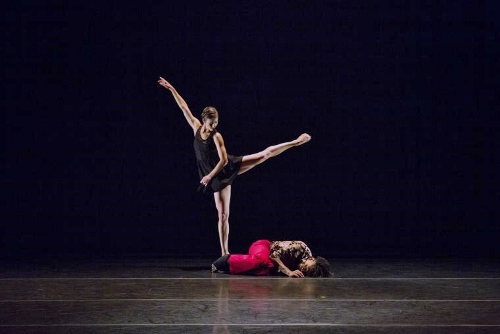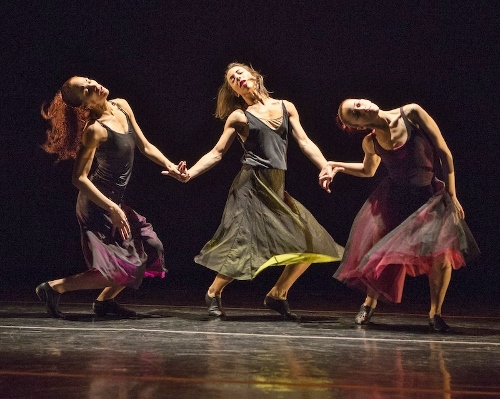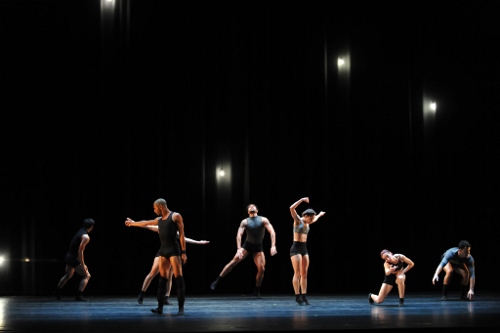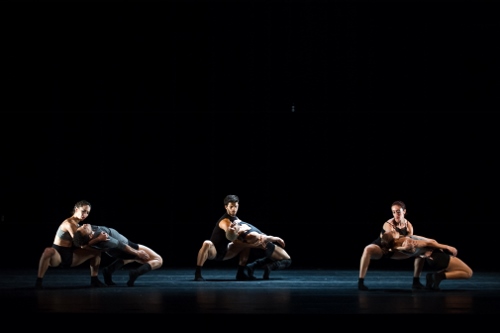|
 |
|
|
 |
 |
While Cuba may only be 103 miles from the United States at its closest point, for many it is worlds away in its mystery as a land seemingly caught in time. So when Cuban contemporary dance company Malpaso returned to Playhouse Square’s Ohio Theatre (they previously performed there in 2016) for two free performances, that immense curiosity once again translated into packed houses to see them. Sponsored by the Cleveland Foundation as part of their Creative Fusion: Cuba Edition, and presented by DANCECleveland as a launch to their 2017-18 season, Malpaso proved once again they are more than mere curiosity, they are a world-class dance troupe with a unique fusion of influences and styles. Their program on June 3, began as their previous Cleveland one did with company artistic director Osnel Delgado’s 13-minute duet “Ocaso” (Sunset), set to music by Kronos Quartet, Max Richter and English electronic music duo Autechre. As the stage lights came up on dancers Daile Carrazana and Abel Rojo they had their backs to the audience. Side-by-side, arms wrapped around each other they then walked toward the back of the stage like lovers out on a stroll. At times, each dropped and dipped their body at the other’s side; perhaps a metaphor for the ups and downs common in a romantic relationship. This vision of a couple’s intimate bond played out throughout the duet manifesting itself in changes in the mood of the work, and in the emotions conveyed by the two dancers who were intently expressive in their happiness as well as in their strife in Delgado’s illustrative choreography. Never straying far from each other’s touch, the dancers swirled around each other like milkweed seeds floating on a breeze. They embraced, leaned on each other and occasionally pushed themselves apart from the other at an energetic pace. From time-to-time that pace was broken by a dancer reclining on the stage floor such as when the tall, but surprisingly nimble Rojo, tenderly lowered mighty mite Carrazana to floor as if she had fallen into slumber. Of the handful of works Delgado has choreographed for the troupe he co-founded in 2012, “Ocaso” is perhaps his most complete. With its engaging choreography, compelling narrative of a couple’s life together and adroit dancing, it was a wonderful lead in to the brilliance that was to follow. Inspired by a transitional moment in choreographer/filmmaker Trey McIntyre’s life when he was burning stacks of old papers from his recently defunct Trey McIntyre Project, “Under Fire” created on Malpaso in 2015, had a cathartic feel to it to go along with McIntyre’s signature ease of movement. A somewhat folksy mood pervaded the piece and like in choreographer Nacho Duato’s works, McIntyre’s innovative, contemporary dance-styled choreography seemed to glide atop a cultural foundation that felt much older in spirit. The 22-minute work for 8-dancers, set to five songs by Boise, Idaho-based singer/songwriter Kelsey Swope (a.k.a. Grandma Kelsey) had Malpaso’s dancers moving about the stage interweaving with one another in patterns a la country-western dance. In the opening section of the work, all eight of its dancers clustered into a group only to have several of them suddenly dart off the stage, leaving behind a smaller group of dancers to carry out a finely-crafted movement phrase. This pattern continued on with delightful invention several more times before a song change sent the dancers off in another equally delightful direction. Most memorable were an athletic solo by Rojo and a powerfully moving duet performed by Delgado and dancer Dunia Acosta to an emotionally searing cover of Dolly Parton’s 1973 ballad “Jolene.” The program closed with choreographer Aszure Barton’s “Indomitable Waltz” (2016), an exploration of the soul under extreme emotional circumstances. Set to an eclectic mix of music from composers Alexander Balanescu, Michael Nyman and Nils Frahm, the 26-minute gem was co-commissioned by DANCECleveland and the Cleveland Foundation. Enchanted by what she saw as the beauty in the decay of Havana’s architecture, Barton created choreography for the dancers to reflect that. Broken ankle-like steps revealed a kind of ugly beauty. Arms wriggled about, dancers hunched like apes traversed the stage in unison, rocking back and forth to the music in a dreamlike waltz and partnered group dances ended with half the dancers being caught in backward falls by their partners who cradled the back of their necks. Throughout the work you got the sense of seeing images related to the dancers’ personal lives and of life in Cuba. Childlike playfulness, solemnness, and an overcoming of obstacles were all filtered through Barton’s quirky movement lens. In the end, as with many of her works, one is left to marvel at Barton’s choreographic peculiarities. With “Indomitable Waltz” that sensation also came with a poignancy that touched the soul as well.
 Malpaso dancers in Osnel Delgado's "Ocaso." Photo © & courtesy of Robert Torres |
|
 Malpaso dancers in Trey McIntyre's “Under Fire.” Photo © & courtesy of Yi-Chun Wu |
|
 Malpaso dancers in Trey McIntyre's “Under Fire.” Photo © & courtesy of Yi-Chun Wu |
|
 Malpaso in Aszure Barton’s “Indomitable Waltz.” Photo © & courtesy of Judy Ondrey |
|
 Malpaso in Aszure Barton’s “Indomitable Waltz.” Photo © & courtesy of Judy Ondrey |
|
|
|






